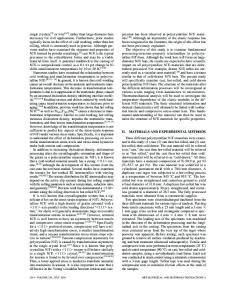Cast NiTi Shape-Memory Alloys
- PDF / 1,351,188 Bytes
- 6 Pages / 612 x 792 pts (letter) Page_size
- 1 Downloads / 432 Views
W1.8.1
Cast NiTi Shape-Memory Alloys Alicia M. Ortega1, Carl P. Frick1, Jeffrey Tyber1, Ken Gall1 and Hans J. Maier2 1 Department of Mechanical Engineering, University of Colorado Boulder, CO 80309, U.S.A. 2 Lehrstuhl für Werkstoffkunde (Materials Science), University of Paderborn 33095 Paderborn, Germany ABSTRACT The purpose of this study is to investigate the structure and properties of polycrystalline NiTi in its cast form. Although it is commonly stated in the literature that cast NiTi has poor shape-memory behavior, this study demonstrates that with appropriate nano/micro structural design, cast NiTi possesses excellent shape-memory properties. Cast NiTi shape-memory alloys may give rise to a new palette of low-cost, complex-geometry components. Results from two different nominal compositions of cast NiTi are presented: 50.1 at.%Ni and 50.9 at.%Ni. The cast NiTi showed a spatial variance in grain size and a random grain orientation distribution throughout the cast material. However, small variances in the thermo-mechanical response of the cast material resulted. Transformation temperatures were slightly influenced by the radial location from which the material was extracted from the casting, showing a change in Differential Scanning Calorimetry peak diffuseness as well as a change in transformation sequence for the 50.9 at.%Ni material. Mildly aged 50.9 at.%Ni material was capable of full shape-memory strain recovery after being strained to 5% under compression, while the 50.1 at.%Ni demonstrated residual plastic strains of around 1.5%. The isotropic and symmetric response under tensile and compressive loading is a result of the measured random grain orientation distribution. The favorable recovery properties in the cast material are primarily attributed to the presence of nanometer scale precipitates, which inhibit dislocation motion and favor the martensitic transformation. INTRODUCTION To date, nearly all applications of NiTi employ a deformation processed and machined material. However, due to NiTi’s poor workability [1] and machinability [2], fabrication of NiTi can be expensive. High cost can make the selection of NiTi an unreasonable choice for many promising applications. Although direct casting could eliminate these costly steps, little work has been done to examine the relationship between structure and properties of NiTi in its cast state, limiting the possibility of its use in potential applications. It has been stated in literature that cast NiTi’s shape recoverability is significantly less than deformation processed NiTi [1,34]. Although initial investigations produced cast NiTi that was brittle and devoid of shapememory behavior [5], later studies have shown improved thermo-mechanical behavior of NiTi in its cast state. Studies done on cast NiTi have examined the tensile and bending response of the cast material and have shown that the cast material can maintain its unique shape-memory and pseudoelastic behavior [6-9]. This prior work has demonstrated the basic potential of cast NiTi shape-memor
Data Loading...











